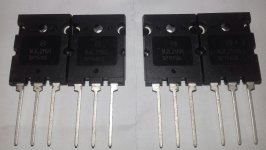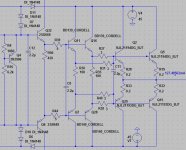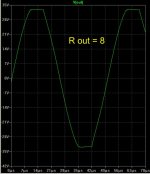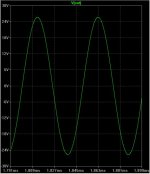Hi everyone! After building numerous chipamps now i'm heading towards discrete amplifiers. I know very little about discrete designs & still learning. It'll take time i believe but despite that i've no dearth of enthusiasm!
Anyway my question is how much power i can get from two pair of mjl 93/94 into 4ohm & 8ohm load(real world use)? Driver transistor recommendation? Actually still i'm struggling to understand SOA. Please help me 🙂
Anyway my question is how much power i can get from two pair of mjl 93/94 into 4ohm & 8ohm load(real world use)? Driver transistor recommendation? Actually still i'm struggling to understand SOA. Please help me 🙂
Attachments
A lot variables you have left out - power supply quality, size of heatsink, what is real world use?
Off the cuff - assuming +/-55Vdc PSU (and it’s decent and heatsink is sufficient) you should get ~125watts at 8-ohms and ~190 watts at 4-ohms
You could push PSU to 60-65Vdc if you are only pushing 8-ohms, but would be at the top of its SOA for any long high volume listening sessions.
Driver could be mje340/350 and bd139 for bias. Google Apex AX14. A lot of variables until you set you intended use
Off the cuff - assuming +/-55Vdc PSU (and it’s decent and heatsink is sufficient) you should get ~125watts at 8-ohms and ~190 watts at 4-ohms
You could push PSU to 60-65Vdc if you are only pushing 8-ohms, but would be at the top of its SOA for any long high volume listening sessions.
Driver could be mje340/350 and bd139 for bias. Google Apex AX14. A lot of variables until you set you intended use
Last edited:
Hi nirupambhowmick,
If your design employs only one pair of MJL21193/94 per channel, I would suggest a safe "real world" power would be around 50W RMS per channel into 8 Ohms. However, I wouldn't expect to be able to sustain 100W RMS into 4 Ohms without adding a second pair in parallel. That said, having two pairs per channel would give you a reliable 75W RMS into 8 Ohms and close to 150W into 4 Ohms.
Although these are 200W 16A devices, one must consider the total power dissipation in the output under the worst condition, the maximum current to be delivered to the load and the transistor's junction temperature. All of these must abide by the transistors safe operating area (SOA) to ensure a robust design. This is covered very well in Bob Cordell's book "Designing Audio Power Amplifiers 2nd Edition". I highly recommend this book for anyone interested in designing audio amplifiers.
In regards to drivers, I would suggest TTC004/TTA004 or KSC3503/KSA1381 would be great options. Good luck with your design.
Cheers
Paul
If your design employs only one pair of MJL21193/94 per channel, I would suggest a safe "real world" power would be around 50W RMS per channel into 8 Ohms. However, I wouldn't expect to be able to sustain 100W RMS into 4 Ohms without adding a second pair in parallel. That said, having two pairs per channel would give you a reliable 75W RMS into 8 Ohms and close to 150W into 4 Ohms.
Although these are 200W 16A devices, one must consider the total power dissipation in the output under the worst condition, the maximum current to be delivered to the load and the transistor's junction temperature. All of these must abide by the transistors safe operating area (SOA) to ensure a robust design. This is covered very well in Bob Cordell's book "Designing Audio Power Amplifiers 2nd Edition". I highly recommend this book for anyone interested in designing audio amplifiers.
In regards to drivers, I would suggest TTC004/TTA004 or KSC3503/KSA1381 would be great options. Good luck with your design.
Cheers
Paul
Hello. Output stage circuit - 2SD669 + 2 x BD139 + 2 x NJL21194DG.
45 volts 8 ohms - 40 W maximum power at 9u% amplifier distortion, 4 ohms - 80 W 30u%.
But it is better to reduce the power supply to 40 volts due to the fact that the
amplification decreases at high current at the output transistors.
45 volts 8 ohms - 40 W maximum power at 9u% amplifier distortion, 4 ohms - 80 W 30u%.
But it is better to reduce the power supply to 40 volts due to the fact that the
amplification decreases at high current at the output transistors.
Attachments
If you are going to bother with an output triple, use something better than a BD139, like MJE15030. If you go 2EF for simplicity, use the high gain ones from Toshiba that were suggested, or something equivalent from Sanken.
By real world load i meant- reactive loads. On the other hand dynamic headroom is a good thing but at the cost of so called sound quality, so i prefer a stiff power supply.A lot variables you have left out - power supply quality, size of heatsink, what is real world use?
Your numbers are very close to what i thought 🙂Off the cuff - assuming +/-55Vdc PSU (and it’s decent and heatsink is sufficient) you should get ~125watts at 8-ohms and ~190 watts at 4-ohms
You could push PSU to 60-65Vdc if you are only pushing 8-ohms, but would be at the top of its SOA for any long high volume listening sessions.
Hi nirupambhowmick,
If your design employs only one pair of MJL21193/94 per channel, I would suggest a safe "real world" power would be around 50W RMS per channel into 8 Ohms. However, I wouldn't expect to be able to sustain 100W RMS into 4 Ohms without adding a second pair in parallel. That said, having two pairs per channel would give you a reliable 75W RMS into 8 Ohms and close to 150W into 4 Ohms.
Hello. Output stage circuit - 2SD669 + 2 x BD139 + 2 x NJL21194DG.
45 volts 8 ohms - 40 W maximum power at 9u% amplifier distortion, 4 ohms - 80 W 30u%.
But it is better to reduce the power supply to 40 volts due to the fact that the
amplification decreases at high current at the output transistors.
I'm assuming a very conservative design because i think one pair is good enough to deliver 100watt into 4ohm load. Anyway thnks for all the ideas.
If you are going to bother with an output triple, use something better than a BD139, like MJE15030. If you go 2EF for simplicity, use the high gain ones from Toshiba that were suggested, or something equivalent from Sanken.
I like bd139/40 transistors, have a lot of them 🙂 MJE150XXX transistors are beast! I would like to buy some.
Last edited:
Not safe with +/-55 volt supplies. When you’re trying to break the 100 watt 8 ohm barrier, they tie one hand behind your back. Fine if you’re making something out of 2N3055’s, but they tend to cripple perfectly good 21194’s.
I think with one pair of 93/94 & 4ohm load maximum safe power supply would be +/-35-40volt, not more than that.
One pair (even with lesser devices like the C5200) on +/-35 ish volts has been done many times before - including with BD139/40 drivers. Certainly do-able. But to make best use of two in parallel, you want the +/-55V supply (and higher voltage drivers). Looks like you’ve got enough for several projects now, anyway.
If you are building a discrete amplifier for the learning experience, then the MJL21193/94 pair will work fine. However, these devices have a low Gain Product Bandwidth (fT) of around 5 - 10MHz. These devices are considered quite slow compared with say the MJL3281A/MJL1302A transistors which have an fT of 20 - 50MHz. The later have much better gain linearity with hFE of 100 at collector currents up to 4A.
If you decide to keep the power into 8 Ohms under 50W RMS then I would suggest to use a standard emitter follower output stage (EF2) as the current demands on the driver/VAS are reasonable. Increasing this to 100W RMS into 8 ohms would benefit from an emitter follower triple (EF3) placing less stress on the earlier stages. This increases the complexity somewhat so choose wisely.
There are some very good EF2 designs on the forum that are well engineered and provide a great starting point for good discrete amplifier designs. The "Honey Badger Amplifier" is well worth checking out if you haven't already.
Cheers
Paul
If you decide to keep the power into 8 Ohms under 50W RMS then I would suggest to use a standard emitter follower output stage (EF2) as the current demands on the driver/VAS are reasonable. Increasing this to 100W RMS into 8 ohms would benefit from an emitter follower triple (EF3) placing less stress on the earlier stages. This increases the complexity somewhat so choose wisely.
There are some very good EF2 designs on the forum that are well engineered and provide a great starting point for good discrete amplifier designs. The "Honey Badger Amplifier" is well worth checking out if you haven't already.
Cheers
Paul
🙂 Yes but still i'm in search of good high voltage driver & VAS transistors. Here the source is very limited you know. As of now for drivers my options are mje340/50, KSA1220/2690, Mje150xxx, but what about VAS?One pair (even with lesser devices like the C5200) on +/-35 ish volts has been done many times before - including with BD139/40 drivers. Certainly do-able. But to make best use of two in parallel, you want the +/-55V supply (and higher voltage drivers). Looks like you’ve got enough for several projects now, anyway.
Yes i know but despite that i chose slow devices like tip35/36c & mjl21193/94 because of my inexperience. I don't want to make an oscillating amplifier, at least with these devices chances are low.If you are building a discrete amplifier for the learning experience, then the MJL21193/94 pair will work fine. However, these devices have a low Gain Product Bandwidth (fT) of around 5 - 10MHz. These devices are considered quite slow compared with say the MJL3281A/MJL1302A transistors which have an fT of 20 - 50MHz. The later have much better gain linearity with hFE of 100 at collector currents up to 4A.
If you decide to keep the power into 8 Ohms under 50W RMS then I would suggest to use a standard emitter follower output stage (EF2) as the current demands on the driver/VAS are reasonable. Increasing this to 100W RMS into 8 ohms would benefit from an emitter follower triple (EF3) placing less stress on the earlier stages. This increases the complexity somewhat so choose wisely.
There are some very good EF2 designs on the forum that are well engineered and provide a great starting point for good discrete amplifier designs. The "Honey Badger Amplifier" is well worth checking out if you haven't already.
Cheers
Paul

Just keep in mind that slow transistors aren't always your friend when it comes to building a stable amplifier.
IMO, the KSC3503 and KSA1381 are the current best devices available for VAS use. I sometimes use the DZT5401 and DZT5551 when I want a SOT-223 device for VAS use.
Now, if you do a cascode VAS, you can get away with higher capacitance transistors - maybe like a TTA/TTC004.
MJE350 and MJE350 would probably be OK for drivers in an EF2 with only one or two output pairs. The MJE15034 and MJE15035 are fantastic. Right now, you're probably going to have to use what you can get, because so many things are out of stock.
IMO, the KSC3503 and KSA1381 are the current best devices available for VAS use. I sometimes use the DZT5401 and DZT5551 when I want a SOT-223 device for VAS use.
Now, if you do a cascode VAS, you can get away with higher capacitance transistors - maybe like a TTA/TTC004.
MJE350 and MJE350 would probably be OK for drivers in an EF2 with only one or two output pairs. The MJE15034 and MJE15035 are fantastic. Right now, you're probably going to have to use what you can get, because so many things are out of stock.
🙂 Yes but still i'm in search of good high voltage driver & VAS transistors. Here the source is very limited you know. As of now for drivers my options are mje340/50, KSA1220/2690, Mje150xxx, but what about VAS?
Any of them would *work*. But there *are* three varieties of MJE1503x pairs, at progressively higher voltages, available. That’s a plus when you’ve got slim pickings because of the supply chain. Higher voltage versions have a bit less gain and lower capacitance, but the one you can get is better than none at all. If you’re doing a EF3 those would be the best choice because you want a smaller one out in front of that.
I often use the same VAS transistor as I do the EF3 predriver. If I do, I darlington it with an MPSA42, which has about the lowest Cob of anything out there. Cascoding works too - pick your poison. I have a 4kW in development with MJE15034/5 VAS and A42/92 to darlington them. Even BIGGER pro amps have used MJE13007/MJE5282 the same way. You can get around the capacitance issue, and darlington sure helps when the hFE is lower.
I’ve run EF2’s with older outputs (2N3773 and 2N6031, specifically) on +/-55 with good jap drivers, and MJE340/A42 darlington VAS, and had no trouble driving 4 ohm speakers at very low distortion. I did run the VAS bias up to 20mA instead of the usual 6 to 10mA, however. A good friend ‘borrowed’ the amp for over 10 years. It sounded better than his old Radio Shack STA-2000D driving those same speakers.
Yes i know but despite that i chose slow devices like tip35/36c & mjl21193/94 because of my inexperience. I don't want to make an oscillating amplifier, at least with these devices chances are low.
As others pointed out, slow outputs are no guarantee of stability. The EF2 and even EF3 are surprisingly tolerant of output fT. It will work with the old 800kHz varieties. Faster sounds better, but once you get it up to a few MHz it’s fast enough and you have to refine the rest of the circuit before you’ll notice anything above that. Other types of compound outputs like CFPs and common emitter stages are MUCH more picky about fT and can get you in trouble. Stick with a darlington type and it will be stable.
Wow, so much information! Thank you 🙂
I'll try to follow things as advised.
I'll be back soon. Have a great day boys! 😎
I'll try to follow things as advised.
I'll be back soon. Have a great day boys! 😎
Hello guys, i'm back. I have a serious question. Do you recommend KSC2690a - KSA1220a as a driver transistor for two pair of Mjl21193/94 +/-55vDC supply and *4ohm* load? I think ksc1381 is more suited for VAS duty due to its lower Cob & mje340/50 is poor choice as driver. Mje15034/35 is excellent but out of my reach(i've to buy 5p min for each polarity).
I believe the KSA1220A are now obsolete however, the KSC2690A is still in production. This is one reason to avoid designs based on them as a driver pair. They are not well suited for designs with supplies above +/- 50V especially with multiple paralleled output pairs.
Consider a 50V pk signal into 4 Ohms, that produces 625W pk (312.5W RMS). The peak current is 12.5A which will be split in half across the two output pairs. Looking at the MJL21193/94 hFE graph shows at 6A beta has reduced from 100 to below 60. This will stress the drivers as they will be required to supply more than 100mA per output pair. This immediately rules out the KSC3503/KSA1381 as drivers as they have a max collector current of 100mA. They are much better suited as a pre-driver in an EF3 output stage.
I agree, the MJE340/50 are a poor choice as a driver and the KSC2690A/KSA1220A are a better choice if you can obtain them.
If you can stretch your budget, the MJE15032/33 or MJE15034/35 would be much better suited due to the greater SOA capability.
Cheers
Paul
Consider a 50V pk signal into 4 Ohms, that produces 625W pk (312.5W RMS). The peak current is 12.5A which will be split in half across the two output pairs. Looking at the MJL21193/94 hFE graph shows at 6A beta has reduced from 100 to below 60. This will stress the drivers as they will be required to supply more than 100mA per output pair. This immediately rules out the KSC3503/KSA1381 as drivers as they have a max collector current of 100mA. They are much better suited as a pre-driver in an EF3 output stage.
I agree, the MJE340/50 are a poor choice as a driver and the KSC2690A/KSA1220A are a better choice if you can obtain them.
If you can stretch your budget, the MJE15032/33 or MJE15034/35 would be much better suited due to the greater SOA capability.
Cheers
Paul
Alright, how about mje15028/29 as driver
in EF2? 120v rated device, similar to mje15030/31(150v).
in EF2? 120v rated device, similar to mje15030/31(150v).
Last edited:
The MJE15028/29 are excellent drivers but have a VCEO of 120V which is marginal with +/- 55V supplies. The MJE15030/31 are higher at 150V and would work fine. You could always drop your supply voltage down and reduce overall power a little. This would give you more driver options for an EF2.
When sizing the output, you will need to decide the maximum current that the amplifier can deliver to a load. There are a number of factors to consider here such as output device SOA, number of parallel devices, current limiting protection etc.
In your case, there are two pairs of output devices which will determine the maximum current without exceeding the SOA of the devices. I prefer to run each pair at a current that results in very little beta droop (very conservative). If I require more current capability, I simply add more output pairs and size the driver accordingly. This tends to make the amplifier very robust.
Cheers
Paul
When sizing the output, you will need to decide the maximum current that the amplifier can deliver to a load. There are a number of factors to consider here such as output device SOA, number of parallel devices, current limiting protection etc.
In your case, there are two pairs of output devices which will determine the maximum current without exceeding the SOA of the devices. I prefer to run each pair at a current that results in very little beta droop (very conservative). If I require more current capability, I simply add more output pairs and size the driver accordingly. This tends to make the amplifier very robust.
Cheers
Paul
- Home
- Amplifiers
- Solid State
- Amplifier using MJL21193/94




